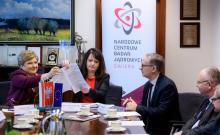Soon, the National Center for Nuclear Research in Świerk will receive more than 17.6 million PLN from European Union toward setting up a research and implementation centre for CentriX industrial radiation techniques. On Monday, February 26, an agreement on financing the project Was signed by the Deputy Marshal of the Masovian Voivodeship, Ms. Janina Orzełowska, by a Member of the Masovian Voivodeship Board, Ms. Elżbieta Lanc and the Director of NCBJ, prof. Krzysztof Kurek.
One of the key equipments in the centre, which will be established at the NCBJ, is going to be the most modern modular accelerator capable of speeding up electrons up to energy of 30 MeV. The modular structure of the accelerator means that, depending on used accelerating structures, it will be possible to produce electron beams of several energies, which then can be converted into high-energy X-rays. Different beam energies are required for studying objects with varied densities and to obtain neutrons (from electron irradiated shields) for required for neutronography. The accelerator will be built by scientists and constructors from Świerk, who will use both commercially available components as well components created from ground up by the Świerk team. The small size of the accelerator (in its basic configuration, its length will be approximately three meters) will allow to use it in the future for constructing relocatable systems used in the commercial sector.
The accelerator will be part of the Fast-X Laboratory within the CentriX project. In addition to generating high-energy X-rays and neutrons, it will also provide electrical capacitance tomography capabilities. The laboratory will also be equipped with detection and imaging systems, including systems used for dynamic imaging. They will include ultrafast X-ray detectors that allow for image processing at 100,000 frames per second. Laboratory scientists will also work on new screening technologies. "Imagine an X-ray or a tomographic image that is thousand times more accurate than currently generated. You can see a thousand times more details on it while a screened patient received a smaller dose of ionizing radiation than is required now” – says with unconcealed passion Professor Sławomir Wronka, the head of the Particle Acceleration Physics & Technology Division at the NCBJ. "Scientists already know how to achieve these results and such first systems are already being built. Probably, no radiologist can today correctly interpret such an accurate picture, but this will change in the future. Initially, engineers who want to look deep into their devices, will take advantage of the new solutions.”
The CentriX project plans also creation of a laboratory for testing detection systems. Laboratory detectors, used by scientific institutions, allow obtaining a huge amount of interesting details, but are usually unsuitable for operating in industrial conditions, especially when measurements need to be made quickly and accurately in extreme conditions such as high temperature, high humidity, high pressure etc. "Detection systems laboratory purpose is to address the commercial sector growing demand for more technologically advanced devices” – explains Dr Jacek Rzadkiewicz, the director of the Nuclear Equipment and Technology Department at the NCBJ. "Today, nuclear technologies allow obtaining quickly extremely valuable information, e. g. about composition and quality of tested raw material samples or products, as well the extent to which parts of tested devices are worn out. We want, in cooperation with potential users, to design, prototype and build detection systems intended to operate in strictly defined external conditions. Intended goals of our work is to prepare detection systems ready for the their practical implementation at the end users."
Research stations in the laboratory will be equipped with radiation sources, including strong impulse neutron generators, calibration kits simulating tested materials and objects as well test beds that will allow a wide range of modifications in operating environmental conditions of the detection systems. "The heart of a detection system is usually a liquid or crystalline scintillator together with an appropriate data processing system” – describes Dr Rzadkiewicz. "The most important task is selection of an appropriate scintillation material that would work correctly under the expected conditions during detector operation. The choice should be confirmed by a series of measurements in variable conditions. Based on the obtained results, we need to develop algorithms for interpreting the data collected by the detector."
The CentriX project includes also plans for creation of a Laboratory Station for Testing Acceleration Structures, which objective will be developing and testing new structures required in radiography. It also includes plans for creation of a Non-Destructive Testing Laboratory in which surface research will be conducted and related technologies developed. This laboratory will complement the already existing potential of the NCBJ Material Research Laboratory. Scientist are striving to make the modern laboratory complex in Świerk to become soon a central laboratory for the network of industrial laboratories supporting directly needs of specific large commercial entities and for local environmental laboratories. These laboratories would carry out measurements required by the end users according to their specific needs, by utilizing technologies, methods and devices developed in the CentriX laboratory.
The total value of the CentriX project will amount to almost 28 million PLN, of which over PLN 17.6 million will be provided by the Regional Operational Program of the Masovian Voivodeship 2014-2020, financed by the European Union. The financing will be under Measure 1.1 – Research and development activity of scientific organizations.









